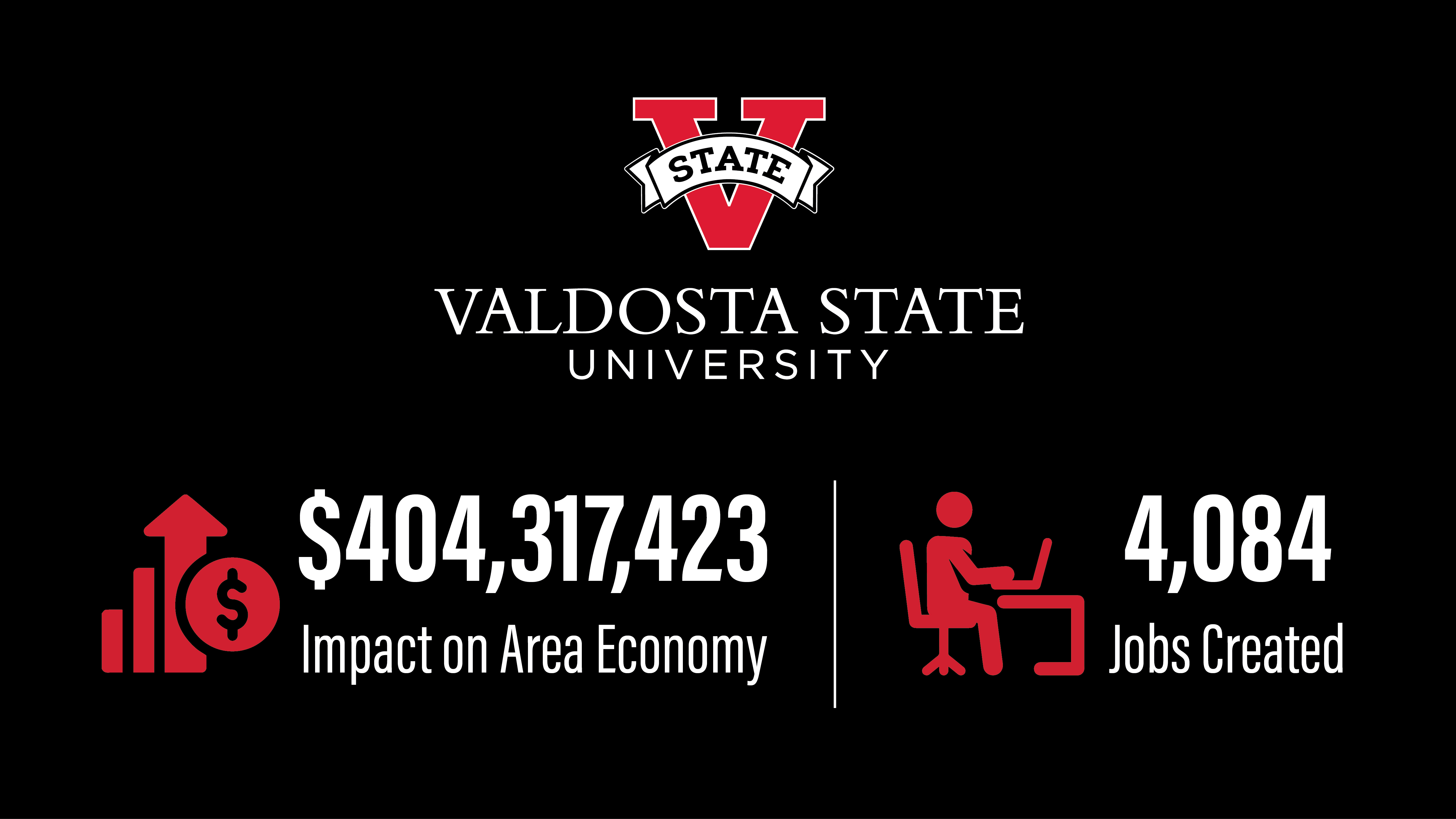August 12, 2022
22-109
Jessica Pope
Communications and Media Relations Coordinator
VSU’s Impact on Area Economy Increases 9.6 Percent Over Previous Year

|
|
Valdosta State University's total economic impact on its host region — defined as Lowndes, Brooks, Lanier, Berrien, Cook, and Echols counties — between July 1, 2020, and June 30, 2021, was a little more than $404.3 million, a 9.6 percent increase compared to the previous year. This includes the creation of 4,084 off-campus jobs in the public and private sectors.
|
Total Economic Impact Surpasses $404 Million
VALDOSTA — How much does Lowndes County and the surrounding areas benefit economically from hosting Valdosta State University?
That is the question the Selig Center for Economic Growth at the University of Georgia’s Terry College of Business set out to answer in a recent study commissioned by the Board of Regents of the University System of Georgia — The Economic Impact of University System of Georgia Institutions on their Regional Economies in Fiscal Year 2021.
Dr. Jeffrey M. Humphreys, director of the Selig Center for Economic Growth, noted that VSU’s total economic impact on its host region — defined as Lowndes, Brooks, Lanier, Berrien, Cook, and Echols counties — between July 1, 2020, and June 30, 2021, was, in the simplest and broadest possible terms, a little more than $404.3 million, a 9.6 percent increase compared to the previous year. This includes the creation of 4,084 off-campus jobs in the public and private sectors.
“At Valdosta State University our mission to advance this region we call home is something we take very seriously,” shared Dr. Richard A. Carvajal, president of VSU. “To know that VSU’s economic impact grew nearly 10 percent during a pandemic — and we created more than 4,000 off-campus jobs in the public and private sectors — demonstrates that we found a way to work together to help our university and our region not only survive but also thrive during this global health crisis.
“As the flagship institution of higher education in South Georgia, it is inspiring to see how our efforts on campus and through our public/private partnerships contribute to the area’s progress and prosperity. With an economic impact of over $400 million, we are committed to doing our part to help drive post-pandemic economic recovery and support the continued economic growth of our region.”
Humphreys’ report provided additional information about the economic impact of spending by VSU as an institution of higher education, by VSU employees, and by VSU students.
Initial Spending — $340,507,052
According to the report, total initial spending accruing to VSU’s regional economy is the combination of three types of spending — spending by the university for personnel services, spending by the university for operating expenses, and spending by the university’s students.
Spending originating from personnel services accounted for about 27.5 percent ($93,632,875) of initial spending during Fiscal Year 2021. Spending due to operating expenses accounted for about 20.1 percent ($68,595,472) of initial spending. Student personal expenditures accounted for about 52.4 percent ($178,278,705) of initial spending.
Total Output Impact — $404,317,423
According to the report, output impact was calculated for each category of initial spending, based on the impact of the first round of spending and the impacts generated by the re-spending of these amounts — the multiplier effect. Total output impacts are the most inclusive, largest measures of economic impact.
Of VSU’s total output impact, 84.2 percent ($340,507,052) was initial spending, while 15.8 percent ($63,810,371) was the induced/re-spending impact or multiplier effect, or the difference between output impact and initial spending. The multiplier captures the regional economic repercussions of the flows of re-spending that take place throughout the region until the initial spending has completely leaked to other regions
On average, every dollar of initial spending generated an additional 18.7 cents for the economy of VSU’s host region during Fiscal Year 2021.
Total Value-Added Impact — $258,338,377
According to the report, value-added impacts, which exclude expenditures related to foreign and domestic trade, provide a much more accurate measure of the actual economic benefits flowing to businesses and households in VSU’s host region than the more inclusive output impacts.
VSU’s value-added impact equaled about 63.9 percent of its $404.3 million output impact, with foreign and domestic trade comprising the remaining 36.1 percent of the output impact during Fiscal Year 2021.
Labor Income Impact — $164,120,506
According to the report, VSU generated a labor impact on its host region of $164,120,506 in Fiscal Year 2021. The labor income received by Lowndes County and neighboring communities represents 63.5 percent of the value-added impact.
Employment Impact — 4,084
According to the report, the economic impact of hosting VSU is most easily understood in terms of the university’s impact on employment. VSU generated an employment impact of 4,084 jobs in Lowndes County and surrounding communities in Fiscal year 2021.
Approximately 34.4 percent (1,406) of these positions are on-campus jobs, while 65.6 percent (2,678) are off-campus jobs in the public or private sector that exist due to VSU-related spending.
In his report, Humphreys stated, “These economic impacts demonstrate that continued emphasis on colleges and universities as a pillar of the state’s economy translates into jobs, higher incomes, and greater production of goods and services.”
Visit https://www.usg.edu/news/release/university_system_of_georgias_economic_impact_grows_to_19.3_billion to learn more about the University System of Georgia’s collective economic impact on Georgia and view the full 27-page report.
On the Web:www.valdosta.edu
Newsroom
- Office of Communications Powell Hall West, Suite 1120
-
Mailing Address
1500 N. Patterson St.
Valdosta, GA 31698 - General VSU Information
- Phone: 229.333.5800
- Office of Communications
- Phone: 229.333.2163
- Phone: 229.333.5983
